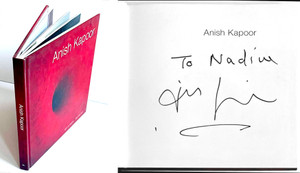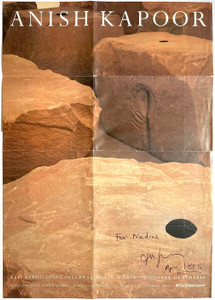
Anish Kapoor, Tall Tree and the Eye at the Royal Academy (hand signed by Anish Kapoor), 2009
Anish KapoorAnish Kapoor
Tall Tree and the Eye at the Royal Academy (hand signed by Anish Kapoor), 2009
Off-set lithograph poster (hand signed by Anish Kapoor)
Signed in black marker lower right front
42 1/2 × 36 inches
Unframed
This offset lithograph poster, published in 2009, was published in an unsigned edition; however, the present print was, exceptionally, hand signed by Anish Kapoor for the present owner in black marker lower right front
Below is an excerpt from a contemporaneous article about the installation:
"Anish Kapoor's towering new sculpture, Tall Tree and the Eye, has gone up in the courtyard of The Royal Academy of Arts ready for an official unveiling on Tuesday as a major exhibition of the artist's work opens in the London gallery.
The steel structure, an arrangement of 76 shiny spheres which bubble up to the level of the surrounding Palladian buildings, is inspired by the words of the German poet Rainer Maria Rilke.
"It is a conjunction of images I have always loved in his Sonnets to Orpheus and this work is, in a way, a kind of eye which is reflecting images endlessly," said Kapoor. Fifteen metres high, it has a look of weightlessness when viewed from the ground below. "Now it is up, I am surprised by its fragility," added the artist.
"There is nothing heavy or imposing about it, but there is something quite improbable. You cannot tell how it has been put up and that is part of its mystery and dignity."
The Kapoor said he is intrigued by the empty spaces between the shapes he has made, and by the endless, repeating "fractal images" reflected on its polished surfaces. "Inevitably the shape recalls DNA as a reference, but that is not what it is," he said.
Kapoor, who won the Turner Prize in 1991, has become one of the world's most highly-regarded creators of public art since 2002 when his red, trumpet-like work Marsyas, dominated the Tate Modern's Turbine Hall.
Born in Mumbai in 1954, this week he will become the first British contemporary artist to be given all the main galleries at the Royal Academy for a solo show.
"This is a venerable institution where some of the greatest of art of all time has been seen," the sculptor said. "Its galleries are some of the most beautiful spaces in the world. So it is a great honour for me and the academy has been incredibly courageous on going with me on this project."
The show features more than 50 sculptures not seen before, as well as several controversial works, such as Shooting into the Corner in which gobbets of red wax are fired into a gallery wall from a cannon. The mobile centrepiece, or show-stealer, inside the galleries is Svayambh, Kapoor's large moving block of red wax that rubs itself around the doorways and walkways of the gallery. The title of this work comes from a Sanskrit word meaning "self-generated".
Kapoor, who studied at Chelsea School of Art and was elected to the Royal Academy 10 years ago, created the most expensive piece of public art in the world in 2004 with his 20m polished steel shape, Cloud Gate. The piece stood in Chicago for two years and cost $23m to make.
The artist, honoured with a CBE in 2003, is now making the world's largest commission, a £15m series of five pieces, known as the Tees Valley Giants, which will stand in the north-east of England.
Anish Kapoor exhibition is at the Royal Academy, London W1, from 26 September to 11 December. "
-The Guardian
Sculptor Anish Kapoor has undertaken investigations into objecthood that have expanded Post-Minimalist practices and
had a profound effect on the course of contemporary sculpture. His monumental Tall Tree & The Eye consists of 73 reflective spheres anchored around three axes. This illusionistic work continues the artist's examination of complex mathematical and structural principles embodied in sculptural form. The mirrored surfaces of the orbs reflect and refract one another, simultaneously creating and dissolving form and space. Images of the surrounding city, including the Nervión river, Daniel Buren's sculptural intervention on the neighboring La Salve Bridge Arcos rojos/Arku gorriak, and the Guggenheim Museum Bilbao itself, are cast into dynamic suspension. Kapoor reminds us of the instability and ephemerality of our vision, and by extension, of our world.
-Courtesy Guggenheim Bilbao
About Anish Kapoor:
Anish Kapoor is one of the most influential sculptors of his generation. Perhaps most famous for public sculptures that are both adventures in form and feats of engineering, Kapoor manoeuvres between vastly different scales, across numerous series of work. Immense PVC skins, stretched or deflated; concave or convex mirrors whose reflections attract and swallow the viewer; recesses carved in stone and pigmented so as to disappear: these voids and protrusions summon up deep-felt metaphysical polarities of presence and absence, concealment and revelation. Forms turn themselves inside out, womb-like, and materials are not painted but impregnated with colour, as if to negate the idea of an outer surface, inviting the viewer to the inner reaches of the imagination. Kapoor’s geometric forms from the early 1980s, for example, rise up from the floor and appear to be made of pure pigment, while the viscous, blood-red wax sculptures from the last ten years – kinetic and self-generating – ravage their own surfaces and explode the quiet of the gallery environment. There are resonances with mythologies of the ancient world – Indian, Egyptian, Greek and Roman – and with modern times.
Anish Kapoor was born in Mumbai, India in 1954 and lives and works in London. He studied at Hornsey College of Art, London, UK (1973–77) followed by postgraduate studies at Chelsea School of Art, London, UK (1977–78). Recent solo exhibitions include Gallerie dell'Accademia di Venezia and Palazzo Manfrin, Venice, Italy (2022); Modern Art Oxford, UK (2021); Museum of Contemporary Art and Urban Planning, Shenzhen, China (2021); Houghton Hall, Norfolk, UK (2020); Pinakothek der Moderne, Munich, Germany (2020); ‘Surge’ at Fundación Proa, Buenos Aires, Argentina (2019); Central Academy of Fine Arts Museum and Imperial Ancestral Temple, Beijing, China (2019); CorpArtes, Santiago, Chile (2019); Pitzhanger Manor and Gallery, London, UK (2019); Serralves Museum, Porto, Portugal (2018); ‘Descension’’ at Public Art Fund, Brooklyn Bridge Park Pier 1, New York, NY, USA (2017); Parque de la Memoria, Buenos Aires, Argentina (2017); MAST Foundation, Bologna, Italy (2017); Museo Universitario Arte Contemporáneo (MUAC), Mexico City, Mexico (2016); Couvent de la Tourette, Eveux, France (2015); Château de Versailles, Versailles, France (2015) and The Jewish Museum and Tolerance Center, Moscow, Russia (2015). He represented Britain at the 44th Venice Biennale in 1990 with Void Field (1989), for which he was awarded the Premio Duemila for Best Young Artist. Kapoor won the Turner Prize in 1991 and has honorary fellowships from the University of Wolverhampton, UK (1999), the Royal Institute of British Architecture, London, UK (2001) and an honorary doctorate from the University of Oxford, UK (2014). Anish Kapoor was awarded a CBE in 2003 and a Knighthood in 2013 for services to visual arts. Large scale public projects include Cloud Gate (2004) in Millennium Park, Chicago, USA and Orbit (2012) in the Queen Elizabeth Olympic Park, London, UK and Ark Nova (2013) the world's first inflatable concert hall in Japan.
Courtesy of Lisson Gallery








